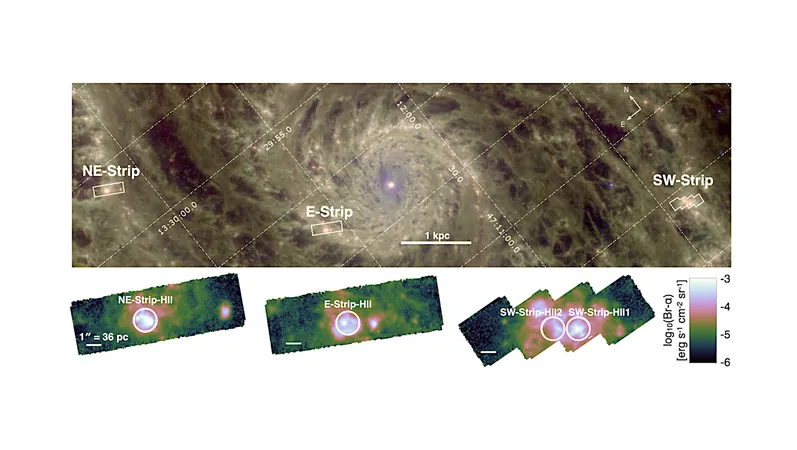
Astounding Discovery: Deuterated Hydrocarbon Nanoparticles Unveiled in the Whirlpool Galaxy
2025-05-18
Author: Wei Ling
Unraveling the Mysteries of Deuteration in Space
In a groundbreaking discovery, scientists have detected deuterated hydrocarbon nanoparticles in the Whirlpool Galaxy, also known as M51. This finding may hold the key to understanding the puzzlingly low levels of deuterium in the universe.
What Did the James Webb Space Telescope Reveal?
Using the advanced capabilities of the James Webb Space Telescope (JWST), researchers analyzed spectra from four star-forming regions within M51. They identified a striking emission feature associated with the C-D stretching mode in aliphatic hydrocarbons. This feature, peaking at approximately 4.647 µm, reveals crucial details about the composition of these interstellar materials.
Impressive Deuteration Levels Observed
The aliphatic hydrocarbons exhibited an astonishing deuteration ratio of (D/H)aliph ≈ 0.17 ± 0.02, indicating a remarkable enrichment of roughly 10,000 times compared to the overall interstellar medium. These elevated deuteration levels, observed on scales of around 50 parsecs, were found to be 2-3 times higher than those detected in the famous Orion Bar photodissociation region (PDR).
Implications for Cosmic Chemistry
Such high levels of deuteration could provide critical insights into the evolutionary processes of hydrocarbon nanoparticles, including polycyclic aromatic hydrocarbons (PAHs). Interestingly, the study also revealed that deuteration of these aliphatic materials is inversely correlated with helium ionization in the HII regions, suggesting that extreme far-ultraviolet (FUV) radiation might suppress deuteration near massive stars.
Curious Absence of Aromatic Deuteration
In contrast, the research found no notable deuteration in aromatic materials—with a ratio of (D/H)arom ≤ 0.016. This indicates that deuteration in aliphatic hydrocarbons significantly surpasses that of their aromatic counterparts by at least a factor of ten.
The Significance of These Findings
These remarkable observations may explain the depletion of deuterium detected in the Galactic interstellar medium. If confirmed, the unique 4.65 µm feature could soon be detectable in absorption, opening up new avenues for research into the cosmic origins of matter.
The Team Behind the Discovery
This exciting study was conducted by an accomplished team of astrophysicists, including B.T. Draine, Karin Sandstrom, Daniel A. Dale, and many others, and is documented in a revised version of their paper published in the Astrophysical Journal Letters.

 Brasil (PT)
Brasil (PT)
 Canada (EN)
Canada (EN)
 Chile (ES)
Chile (ES)
 Česko (CS)
Česko (CS)
 대한민국 (KO)
대한민국 (KO)
 España (ES)
España (ES)
 France (FR)
France (FR)
 Hong Kong (EN)
Hong Kong (EN)
 Italia (IT)
Italia (IT)
 日本 (JA)
日本 (JA)
 Magyarország (HU)
Magyarország (HU)
 Norge (NO)
Norge (NO)
 Polska (PL)
Polska (PL)
 Schweiz (DE)
Schweiz (DE)
 Singapore (EN)
Singapore (EN)
 Sverige (SV)
Sverige (SV)
 Suomi (FI)
Suomi (FI)
 Türkiye (TR)
Türkiye (TR)
 الإمارات العربية المتحدة (AR)
الإمارات العربية المتحدة (AR)